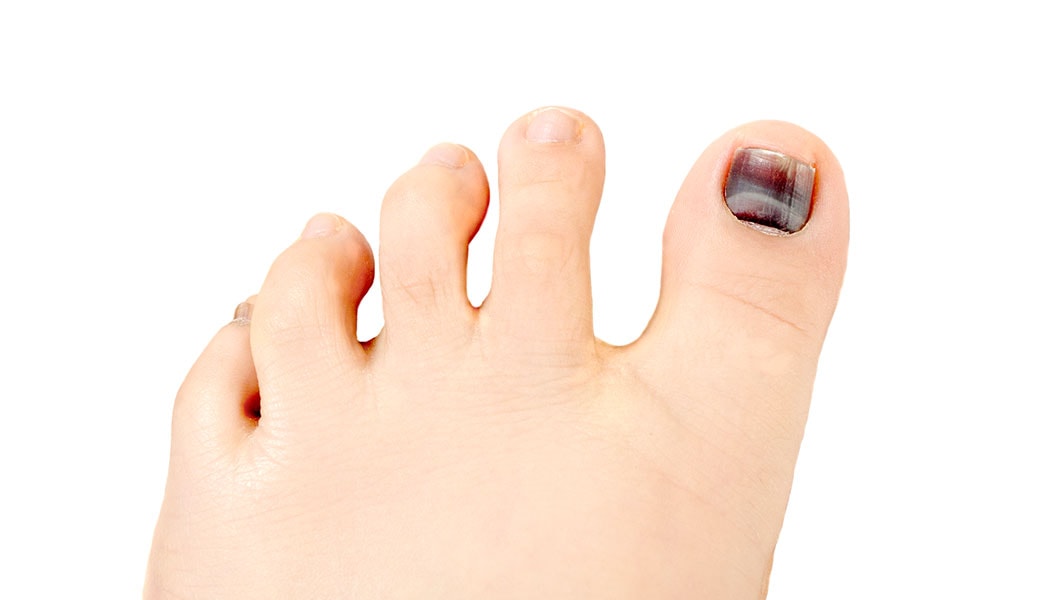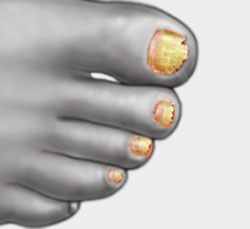- Home
- Foot & Ankle Conditions
- Toenails Conditions
- Toenail Fungus
Toenail Fungus: causes, symptoms and treatment
- Published 6/1/2018
- Last Reviewed 7/22/2024

What's Toenail Fungus?
Fungal infections of the nail plate (also known as onychomycosis) are the most common nail disease.
Various types of fungi are present everywhere in the environment, and most are harmless until they penetrate the skin.
A fungus can invade through minor cuts or after injury. Repeated irritation to the toes may cause the nail to separate from the bed, making the toes vulnerable.
- What are the symptoms of toenail fungus?
- What causes toenail fungal infections?
- What are fungal toenail treatment options?
- How to prevent toenail fungus
- Other types of nail infections
- University Foot and Ankle Institute, the Best Choice for Onychomycosis Treatment
- Frequently Asked Questions about Toenail Fungus
- How effective is laser treatment compared to taking meds to kill the toenail fungus? And which helps prevent re-occurrences better?
- How effective are laser devices for nail fungus treatment?
- How effective are topical antifungal creams in the treatment of onychomycosis?
- How long does it take for the new nail to grow following a laser treatment session?
- Is laser treatment for toenail fungus covered by insurance?
- What's a mycotic nail?
-
Foot and Ankle Surgeon at University Foot and Ankle Institute
Dr. Justin Franson, DPM, is a Board Certified Podiatric Foot and Ankle Specialist and Diplomate of the American Board of Podiatric Surgery. He attended the School College of Podiatric Medicine in Chicago, graduating in 2001. Dr. Franson then accepted a three-year residency program at the Greater Los Angeles VA and UCLA County Hospital.
Dr. Franson specializes in several areas including total ankle replacement and sports medicine. Treating athletes and weekend warriors like himself brings him a lot of joy. Dr. Franson keeps active with running marathons, triathlons, hiking, basketball, and golf.
Learn More from our Toenail Fungus Blog Articles
- What To Do When Your Toenail Is Falling Off
- Couples Living Together Share a Lot of Things, Even the Bacteria on Their Feet
- Can a Blow Dryer Prevent Toenail Fungus?
- Paronychia: Treating and Avoiding Annoying Nail Infections
- What Causes a Black Toenail? Should You Be Worried?
- Treating Athlete’s Foot with Garlic? Prepare to Be Burned, Literally!
 The perfect dr(Baravarian) and perfect team and polite serviceTina K.
The perfect dr(Baravarian) and perfect team and polite serviceTina K. I liked it.Liisa L.
I liked it.Liisa L. I depend on the doctors at UFAI to provide cutting edge treatments. Twice, I have traveled from Tucson, Arizona to get the car...Jean S.
I depend on the doctors at UFAI to provide cutting edge treatments. Twice, I have traveled from Tucson, Arizona to get the car...Jean S. They helped me in an emergency situation. Will go in for consultation with a Dr H????
They helped me in an emergency situation. Will go in for consultation with a Dr H????
Re foot durgeryYvonne S. It went very smoothly.Maria S.
It went very smoothly.Maria S. My experience at the clinic was wonderful. Everybody was super nice and basically on time. Love Dr. Bavarian and also love the ...Lynn B.
My experience at the clinic was wonderful. Everybody was super nice and basically on time. Love Dr. Bavarian and also love the ...Lynn B. I fill I got the best service there is thank youJames G.
I fill I got the best service there is thank youJames G. My experience with your practice far exceeded any of my expectations! The staff was always friendly, positive and informative. ...Christy M.
My experience with your practice far exceeded any of my expectations! The staff was always friendly, positive and informative. ...Christy M. Love Dr. Johnson.Emily C.
Love Dr. Johnson.Emily C. Easy check in. Did not wait hardly at all for my exam. Very professional and knowledgeable.Cortisone shot almost took all the ...Alec M.
Easy check in. Did not wait hardly at all for my exam. Very professional and knowledgeable.Cortisone shot almost took all the ...Alec M. I am a new patient and felt very comfortable from the moment I arrived to the end of my visit/appointment.Timothy L.
I am a new patient and felt very comfortable from the moment I arrived to the end of my visit/appointment.Timothy L. My feet have been killing me for the past two months and put off getting it checked out. I finally came to see Dr. Breskin and ...Cynthia S.
My feet have been killing me for the past two months and put off getting it checked out. I finally came to see Dr. Breskin and ...Cynthia S.
-
 Listen Now
What To Do When Your Toenail Is Falling Off
Read More
Listen Now
What To Do When Your Toenail Is Falling Off
Read More
-
 Listen Now
What Causes a Black Toenail? Should You Be Worried?
Read More
Listen Now
What Causes a Black Toenail? Should You Be Worried?
Read More
-
 Listen Now
Couples Living Together Share a Lot of Things, Even the Bacteria on Their Feet
Read More
Listen Now
Couples Living Together Share a Lot of Things, Even the Bacteria on Their Feet
Read More
-
 Treating Athlete’s Foot with Garlic? Prepare to Be Burned, Literally!
Read More
Treating Athlete’s Foot with Garlic? Prepare to Be Burned, Literally!
Read More
-
 Listen Now
Can a Blow Dryer Prevent Toenail Fungus?
Read More
Listen Now
Can a Blow Dryer Prevent Toenail Fungus?
Read More
-
 Listen Now
Paronychia: Treating and Avoiding Annoying Nail Infections
Read More
Listen Now
Paronychia: Treating and Avoiding Annoying Nail Infections
Read More








